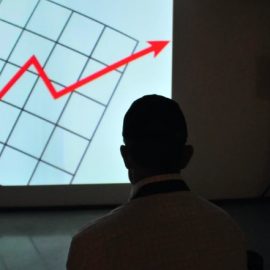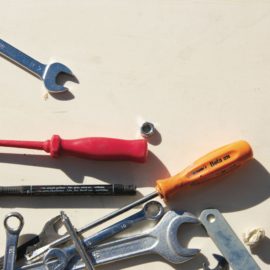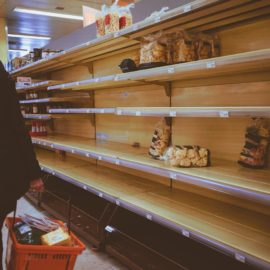
This is a free excerpt from one of Shortform’s Articles. We give you all the important information you need to know about current events and more.
Don't miss out on the whole story. Sign up for a free trial here .
How are the housing market and economy connected? What happens if the housing market crashes? Will there be another recession?
As home prices drop and rumors of recession haunt headlines, concerns are mounting that we might be headed for a repeat of the Great Recession of 2007-2009. According to Naked Economics, modern markets are all interconnected, so the failure of one part of the economy can cause a domino effect.
Read on to learn what the future holds for the U.S. housing market and the larger economy.
Housing Markets & the Economy
As we face a softening housing market, the economy as a whole could be negatively impacted as fears of the Great Recession of 2007-2009 loom. Due to the pandemic, demand for homes surged in 2020 and 2021: Bidding wars sent prices skyrocketing and buyers waived inspections or offered cash to beef up their offers. Between February 2020 and June 2022, home prices rose by 44%.
Today, sales of new and existing homes have fallen by close to 30% since January and home prices have started to decline. Many industry watchers expect prices to continue to fall between 5% and 10%, and some are predicting double-digit decreases.
The primary driver of the housing market downturn is the spike in mortgage rates triggered by the Federal Reserve’s recent interest rate increases. Average rates for 30-year fixed mortgages have risen to more than 7%; through much of the past few years, they hovered around 3%.
This makes homes more expensive: A buyer today can get a house of $300,000 for the same monthly payment that would have afforded them a house of $460,000 last year.
The predictable result is that homebuyers are hesitating. Mortgage applications are at their lowest levels since 2000, and homes are sitting on the housing market longer.
What’s the Danger to the Larger Economy?
The concern is that the softening housing market will bleed into the wider economy, and that industries selling goods like appliances, lumber, and windows will also see decreased demand.
If demand for these goods falls and prices do too, the Fed will have achieved its goal of dampening inflation. However, this success might come on the back of economic pain if falling consumer spending leads to a recession.
The Health of an Economy
According to Naked Economics by Charles J. Wheelan, in order to properly evaluate the strength of an economy, economists must first figure out how to measure economies. There are several markers of economic health that they look at, but the primary one is an economy’s gross domestic product, or GDP. GDP summarizes the value of all the goods and services an economy produces. It’s the number that people generally refer to when they talk about a country’s growth: If you say the U.S. grew 3 percent this year, what you mean is that the U.S. produced 3 percent more goods and services this year than it did last year.
In addition to GDP, there are some other numbers that economists often refer to in order to judge how an economy is faring. These include:
- Unemployment rate: This number measures the percentage of people who don’t have a job but are looking for one. In general, a lower unemployment rate indicates a stronger economy, because there are plenty of jobs to go around. However, a too-low unemployment rate indicates a lack of skilled workers, which can hold back an economy’s growth.
- Poverty rate: This number measures the percentage of a population living below a certain level of income. A high poverty rate typically indicates a poorly run economy.
- Gini coefficient: This number uses a scale of zero to 100 to measure income inequality. A score of zero indicates total equality, where every worker earns the same amount. A score of 100 indicates total inequality, where one worker earns all the income. By this measure, America has grown more unequal over time: In 1950, the country scored 37.9, while in 2007, it scored 45. Economies that are more equal tend to have longer-term stability.
How Do Recessions Happen?
Recessions are periods of time during which an economy’s GDP shrinks. They’re generally caused by a shock to the system—something unexpected and bad happening. Shocks to the economy might be the bursting of stock market or housing bubbles (when exorbitant price increases are followed by sudden and devastating losses), a steep rise in oil prices, or a combination of such causes.
Because all parts of modern markets are interconnected, the failure of one part of the economy can quickly cause other parts to fail as well. For example, if your income suddenly drops because of a stock market correction, you will respond by spending less money. Your decreased spending makes other people’s income decrease, who then respond by also spending less money, which spreads the pain throughout more and more sectors of the market.
When this kind of slowdown reaches banks, the entire economy can quickly freeze up. When banks stop lending money because they fear people caught in a downward economic cycle can’t pay it back, businesses can’t operate. This is what happened to the economy during the housing market crisis that began in 2007. Homeowners took on more debt than they could finance in order to pay for new homes, fueling a property bubble. When housing prices fell, people unable to honor their loans found they couldn’t sell their homes for enough money to cover their outstanding mortgages, and the resulting wave of foreclosures devastated investment banks. When Lehman Brothers, a major investment bank, declared bankruptcy, the global financial market froze as panicked banks stopped lending people money.
Countering Recessions
To counter shocks to the economy and consequent recessions, like the housing market crisis, governments can change their fiscal policies or their monetary policies to encourage businesses to begin investing and consumers to start spending, so that the economy becomes self-sustaining again.
Fiscal policies: A government can encourage spending by injecting money into the economy, either by cutting taxes or by creating stimulus programs that put money directly into the hands of consumers and businesses.
Monetary policies: A government controls the supply of money in an economy by increasing or decreasing short-term interest rates. Cutting interest rates allows consumers to buy more things and allows firms to invest. Raising interest rates puts a brake on the economy by raising the cost of money itself, making it harder for individuals and businesses to borrow capital.
A government can decrease interest rates to heat up an economy, but it must be careful that it doesn’t go too far and cause inflation—a continuous rise in prices. When interest rates are low, people borrow more money, and with more money running through an economy, prices for goods typically rise.
If, however, a government errs on the opposite end of the spectrum with interest rates that are too high, it can tip an economy into recession. When interest rates are high, borrowing money becomes expensive and people and firms stop taking out loans. Consequently, individuals stop spending money on big-ticket items, like housing, education, or home improvement projects, and businesses invest less and hire less, which decreases the number of jobs available.
When Will Mortgage Rates Drop?
For now, many people are making decisions that indicate they believe rates will improve in the future. For example, adjustable rate mortgages (ARMs) are once again popular—though applications for mortgages as a whole have declined for months, applications for ARMs have risen to their highest level since 2008, indicating that people hope a 7% mortgage today might be a 4% mortgage a few years from now.
They may be disappointed. Some analysts expect higher rates to become the new norm, and they point out that for most of the past 50 years, with the exception of the low-interest years starting in 2008, mortgage rates have trended between 6% and 10%—even hanging out in the low teens during the 1980s.
Many thus expect that after the initial sticker shock of higher rates, buyers will acclimate and that in six months or so, people will adapt, accept that higher rates are an inevitable part of home purchases, and resume buying again.
TITLE: Naked Economics
AUTHOR: Charles J. Wheelan
TIME: 49
READS: 69
IMG_URL: https://www.shortform.com/blog/wp-content/uploads/2020/11/naked-economics-cover.png
BOOK_SUMMARYURL: naked-economics-summary-charles-j-wheelan
AMZN_ID: XYZ

Want to fast-track your learning? With Shortform, you’ll gain insights you won't find anywhere else .
Here's what you’ll get when you sign up for Shortform :
- Complicated ideas explained in simple and concise ways
- Smart analysis that connects what you’re reading to other key concepts
- Writing with zero fluff because we know how important your time is






